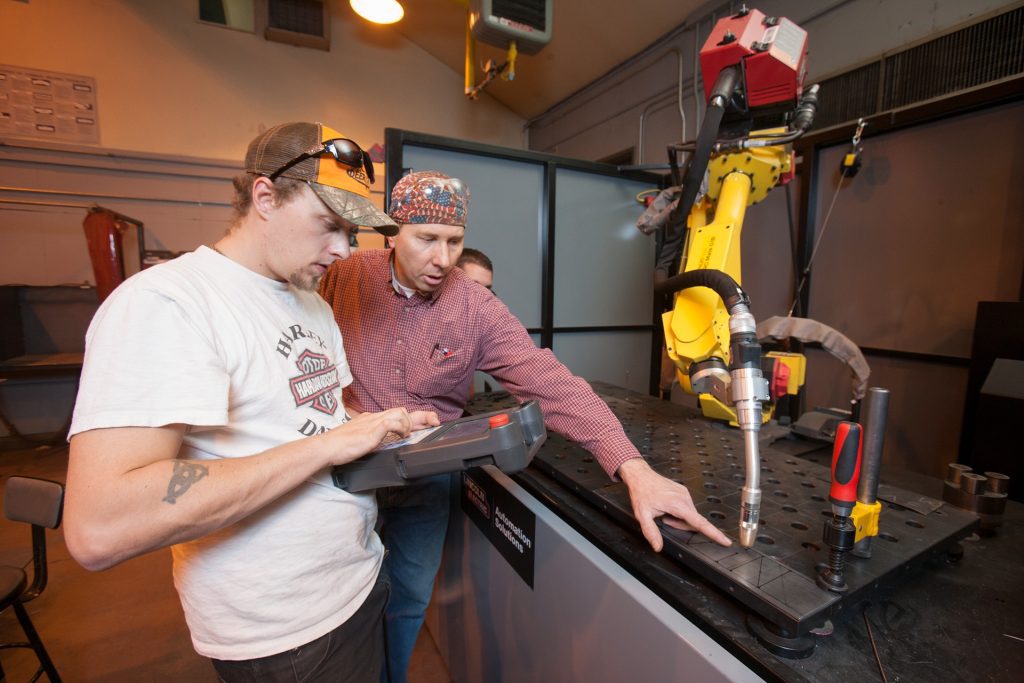Registration for the 2023
Summer Course is open
Welding Technology
Registration for the 2025 Spring Term is open
Welding Technology
The Welding Technology Program is designed to prepare the student with the necessary skills to acquire an entry-level position in the various industries that require the different welding processes available through the Program. The Welding Program is also designed to assist those already employed in the industry and those in the community to improve their skills. The Program offers course work in Oxyacetylene Welding (OAW), Gas Metal Arc Welding (GMAW), Shielded Metal Arc Welding (SMAW), Gas Tungsten Arc Welding (GTAW) and American Welding Society (AWS) qualifications in plate and pipe welding. The curriculum is updated with the assistance of an industry advisory committee.

Program Overview
As a Welding major, you will:
- Study a general welding curriculum including welding plate and pipe and qualifications in multiple welding processes to American Welding Society standards.
- Develop leadership and communication skills.
- Identify the welding careers you are most interested in and build a course of, study to better qualify you to succeed in that career
Program Highlights
- Classes for beginning through advanced welders.
- Welding qualifications through the American Welding Society.
- Practical hands-on training with classroom theory.
- Short term courses.
Associate Degree and Certificate of Achievement in Welding can be completed within two (2) years.
Internships in welding are available for students interested in Work Experience opportunities.
Two-Year Advising Plans
| Degree Type | Degree Name |
| Associate in Science | WeldingTechnology-AS |
| Certificate of Achievement | WeldingTechnology-1-year CA |
| Certificate of Achievement | WeldingTechnology-2-year CA |
| Certificate of Accomplishment | WeldingTechnology-CoA |
Employment Opportunities
Welding Technician
Sales
Inspection
Supervision & Management
Aerospace
Welding Engineering
Construction
Trucking & Automotive
Welding Instructor
Some positions however require a four-year degree for which LCC’s program is a good base for transfer.
Degrees and Certificates
Certificate of Accomplishment: Welding Technology
Total Units for the Certificate of Accomplishment Welding Technology: 12 Units
Required Core Courses: 9 Units
| COURSE NUMBER | TITLE | UNITS |
| WT 20 | Power Plant & Field Pipe Welding I | 3 |
| WT-37 | Welding Theory & Practice – Shielded Metal Arc Welding | 3 |
| WT 38 | Welding Theory & Practice – Gas Metal ArcWelding | 3 |
| Required Electives: 3 Units | ||
| IT-22 | Operations, Maintenance and Safety | 1 |
| IT-72 | Facilities Maintenance - Welding | 2 |
| WT 36 | Welding Theory & Practice - Oxyacetylene | 3 |
| WT-51 | Blueprint and Symbol Reading for Welders | 2 |
| WT-52 | Robotic Operations and Programming | 3 |
Program Student Learning Outcomes
Upon completion of the Certificate of Accomplishment in Welding Technology, the student will be able to:
1. Demonstrate the safe set-up and application of Oxyacetylene Cutting (OAC), Oxyacetylene Welding (OAW), Carbon Arc Cutting (CAC), Gas Tungsten Arc Welding (GTAW), Gas Metal Arc Welding (GMAW), Flux Cored Arc Welding (FCAW), and Shielded Metal Arc Welding (SMAW) to ferrous metals.
2. Describe hazard materials awareness and handling.
3. Interpret technical information used on industrial working and assembly drawings.
Certificate of Achievement: Welding Technology – One Year
Total Units for the One-Year Certificate of Achievement: 23 Units
Required Core Courses: 17 Units
| COURSE NUMBER | TITLE | UNITS |
| IT-22 | Operations, Maintenance and Safety | 1 |
| IT-72 | Facilities Maintenance - Welding | 2 |
| WT 20 | Power Plant & Field Pipe Welding I | 3 |
| WT-21 | Power Plant & Field Pipe Welding II | 3 |
| WT-37 | Welding Theory & Practice – Shielded Metal Arc Welding | 3 |
| WT 38 | Welding Theory & Practice – Gas Metal ArcWelding | 3 |
| WT-51 | Blueprint and Symbol Reading for Welders | 2 |
| Required Electives: 6 Units | ||
| WT 42 | Intermediate Shielded Metal Arc Welding | 3 |
| WT-43 | Advanced Shielded Metal Arc Welding | 3 |
| WT-44 | Gas Metal Arc Welding | 3 |
| WT-45 | Gas Tungsten Arc Welding | 3 |
| WT-52 | Robotic Operations and Programming | 3 |
| WT-53 | Robotic Welding Operations and Programming (Advanced) | 3 |
Program Student Learning Outcomes
Upon completion of the Certificate of Achievement in Welding Technology One-Year, the student will be able to:
1. Demonstrate the safe set-up and application of Oxyacetylene Cutting (OAC), Oxyacetylene Welding (OAW), Carbon Arc Cutting (CAC), Gas Tungsten Arc Welding (GTAW), Gas Metal Arc Welding (GMAW), Flux Cored Arc Welding (FCAW), and Shielded Metal Arc Welding (SMAW) to ferrous, alloy and nonferrous metals.
2. Apply the SMAW, GTAW, GMAW, and FCAW processes to steel plate and pipe that meet or exceed industry standards and the American Welding Society Structural Welding Code, DI.1.
3. Interpret technical information used on industrial working and assembly drawings.
4. Safely power up the controller and jog the robot in world and joint mode within a work cell.
5. Describe hazard materials awareness and handling.
Certificate of Achievement: Welding Technology – Two Year
Total Units for the Two-Year Certificate of Achievement: 44 Units
Required Core Courses: 29 Units
| COURSE NUMBER | TITLE | UNITS |
| IT-22 | Operations, Maintenance and Safety | 1 |
| IT-72 | Facilities Maintenance - Welding | 2 |
| WT 20 | Power Plant & Field Pipe Welding I | 3 |
| WT-21 | Power Plant & Field Pipe Welding II | 3 |
| WT 22 | Power Plant & Field Pipe Welding III | 3 |
| WT 23 | Power Plant & Field Pipe Welding IV | 3 |
| WT 36 | Welding Theory & Practice - Oxyacetylene | 3 |
| WT-37 | Welding Theory & Practice – Shielded Metal Arc Welding | 3 |
| WT 38 | Welding Theory & Practice – Gas Metal ArcWelding | 3 |
| WT 39 | Welding Theory & Practice – Gas Tungsten Arc Welding | 3 |
| WT-51 | Blueprint and Symbol Reading for Welders | 2 |
| Required Electives: 15 Units | ||
| BUS-25 | Small Business Management | 3 |
| WT 42 | Intermediate Shielded Metal Arc Welding | 3 |
| WT-43 | Advanced Shielded Metal Arc Welding | 3 |
| WT-44 | Gas Metal Arc Welding | 3 |
| WT-45 | Gas Tungsten Arc Welding | 3 |
| WT-52 | Robotic Operations and Programming | 3 |
| WT-53 | Robotic Welding Operations and Programming (Advanced) | 3 |
Program Student Learning Outcomes
Upon completion of the Certificate of Achievement in Welding Technology Two-Year, the student will be able to:
1. Demonstrate the safe setup and application of various welding and cutting processes to specific metals and joint designs, which meet or exceed industry standards and the American Welding Society Structural Welding Code, DI.1.
2. Define integrity and its importance to business stakeholders.
3. Interpret technical information used on industrial working and assembly drawings.
4. Safely power up the controller and jog the robot in world and joint mode within a work cell.
5. Describe hazard materials awareness and handling.
Associate in Science Degree Welding Technology
Total Units for the Associate in Science Degree: 60 Units
Required Core Courses: 24 Units
| COURSE NUMBER | TITLE | UNITS |
| WT 20 | Power Plant & Field Pipe Welding I | 3 |
| WT-21 | Power Plant & Field Pipe Welding II | 3 |
| WT 22 | Power Plant & Field Pipe Welding III | 3 |
| WT 23 | Power Plant & Field Pipe Welding IV | 3 |
| WT 36 | Welding Theory & Practice - Oxyacetylene | 3 |
| WT-37 | Welding Theory & Practice – Shielded Metal Arc Welding | 3 |
| WT 38 | Welding Theory & Practice – Gas Metal ArcWelding | 3 |
| WT 39 | Welding Theory & Practice – Gas Tungsten Arc Welding | 3 |
| Required Electives: 18 Units | ||
| BUS-25 | Small Business Management | 3 |
| IT-22 | Operations, Maintenance and Safety | 1 |
| IT-72 | Facilities Maintenance - Welding | 2 |
| WT 42 | Intermediate Shielded Metal Arc Welding | 3 |
| WT-43 | Advanced Shielded Metal Arc Welding | 3 |
| WT-44 | Gas Metal Arc Welding | 3 |
| WT-45 | Gas Tungsten Arc Welding | 3 |
| WT-51 | Blueprint and Symbol Reading for Welders | 2 |
| WT-52 | Robotic Operations and Programming | 3 |
| WT-53 | Robotic Welding Operations and Programming (Advanced) | 3 |
General Education Requirements: 18 Units
Program Student Learning Outcomes
Upon completion of the Associate in Science Degree Welding Technology, the student will be able to:
1. Demonstrate the safe setup and application of various welding and cutting processes to specific metals and joint designs, which meet or exceed industry standards and the American Welding Society Structural Welding Code, DI.1.
2. Define integrity and its importance to business stakeholders.
3. Interpret technical information used on industrial working and assembly drawings.
4. Safely power up the controller and jog the robot in world and joint mode within a work cell.
Your Success is Our Priority

Having the scholarship helped me so much. Having more time to study, more time to practice.

I wanted to adjust to college life and not rush into a big school. Lassen College gave me that opportunity with the friendly staff, smaller class sizes, and good programs […]

I think you should attend Lassen College because of the multiple sports that are involved at the school. It’s a small campus and you get really close with other people.

The Scholarship really helped me and my family by allowing us to save up more money so we could afford to go to a four year school next year.

Having the scholarship helped me so much. Having more time to study, more time to practice.

I wanted to adjust to college life and not rush into a big school. Lassen College gave me that opportunity with the friendly staff, smaller class sizes, and good programs […]

I think you should attend Lassen College because of the multiple sports that are involved at the school. It’s a small campus and you get really close with other people.

The Scholarship really helped me and my family by allowing us to save up more money so we could afford to go to a four year school next year.

Having the scholarship helped me so much. Having more time to study, more time to practice.

I wanted to adjust to college life and not rush into a big school. Lassen College gave me that opportunity with the friendly staff, smaller class sizes, and good programs […]
Contact
Counseling Office
530-251-8842
lcccounseling@lassencollege.edu
